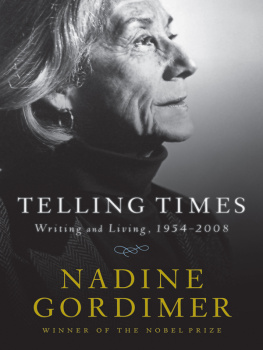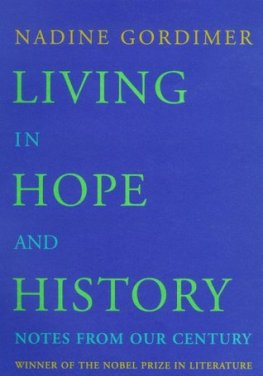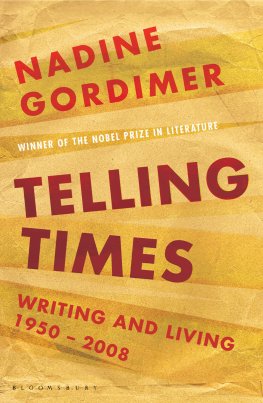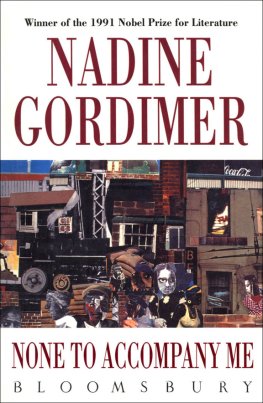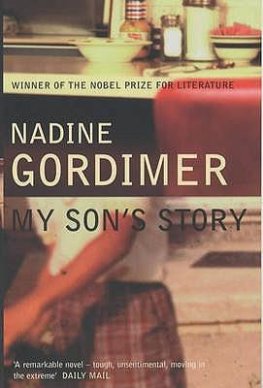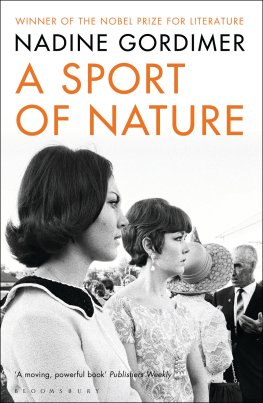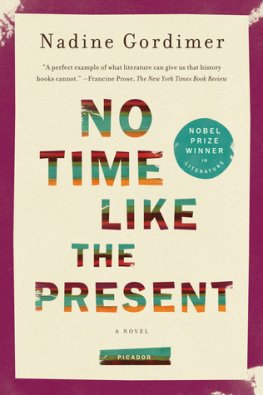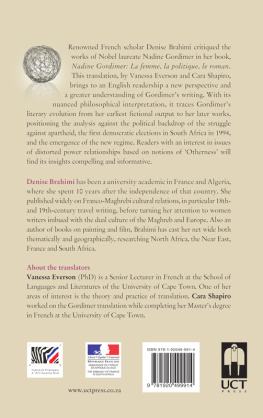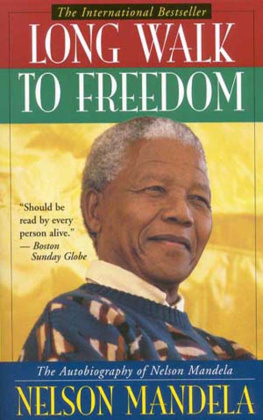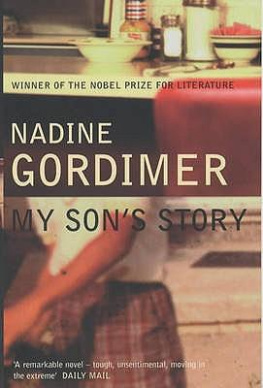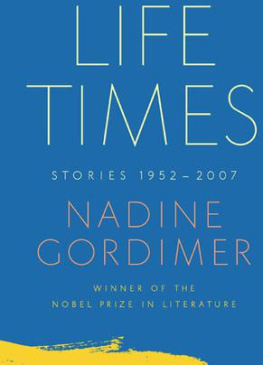
BY THE SAME AUTHOR
NOVELS
The Lying Days / A World of Strangers / Occasion for Loving
The Late Bourgeois World / A Guest of Honour
The Conservationist / Burgers Daughter / Julys People
A Sport of Nature / My Sons Story / None to Accompany Me
The House Gun / The Pickup / Get a Life
STORY COLLECTIONS
The Soft Voice of the Serpent / Six Feet of the Country
Fridays Footprint / Not for Publication
Livingstones Companions
A Soldiers Embrace / Something Out There
Jump / Loot / Beethoven Was One-Sixteenth Black
ESSAYS
The Black Interpreters / On the Mines ( with David Goldblatt )
Lifetimes under Apartheid ( with David Goldblatt )
The Essential Gesture Writing, Politics and Places
( edited by Stephen Clingman )
Writing and Being
Living in Hope and History: Notes from Our Century
EDITOR, CONTRIBUTOR
Telling Tales
TELLING TIMES
Writing and Living, 19542008
NADINE GORDIMER

Copyright 2010 by Nadine Gordimer
First American Edition 2010
All rights reserved
The publishers are grateful to Leo Carey for his meticulous work in preparing the manuscript of this book for press.
For information about permission to reproduce selections from this book, write to Permissions, W. W. Norton & Company, Inc., 500 Fifth Avenue, New York, NY 10110
For information about special discounts for bulk purchases, please contact W. W. Norton Special Sales at specialsales@wwnorton.com or 800-233-4830
Production manager: Anna Oler
The Library of Congress has cataloged the printed edition as follows:
Gordimer, Nadine.
Telling Times : writing and living, 19542008 / Nadine Gordimer. 1st American ed.
p. cm.
The first comprehensive collection of Gordimers nonfiction.
ISBN 978-0-393-06628-9 (hardcover)
I. Title
PR9369.3.G6T46 2010
828'.914dc22 2010008153
ISBN 978-0-393-08221-0 (e-book)
W. W. Norton & Company, Inc.
500 Fifth Avenue, New York, N.Y. 10110
www.wwnorton.com
W. W. Norton & Company Ltd.
Castle House, 75/76 Wells Street, London W1T 3QT
Reinhold Cassirer
12 March 1908 17 October 2001
1 March 1953 17 October 2001
G rowing up in one part of a vast young country can be very different from growing up in another, and in South Africa this difference is not only a matter of geography. The division of the people into two great races black and white and the subdivision of the white into Afrikaans- and English-speaking groups provides a diversity of cultural heritage that can make two South African children seem almost as strange to each other as if they had come from different countries. The fact that their parents, if they are English-speaking, frequently have come from different countries complicates their backgrounds still further. My father came to South Africa from a village in Russia; my mother was born and grew up in London. I remember, when I was about eight years old, going with my sister and mother and father to spend a long weekend with a cousin of my fathers who lived in the Orange Free State. After miles and miles of sienna-red ploughed earth, after miles and miles of silk-fringed mealies standing as high as your eyes on either side of the road and ugly farmhouses where women in bunchy cotton dresses and sun-bonnets stared after the car as we passed (years later, when I saw Oklahoma! in a Johannesburg theatre, I recalled that scene), we reached the dorp where the cousin lived in a small white house with sides that were dust-stained in a wavering wash, like rust, for more than a foot above the ground. There we two little girls slept on beds of a smothering softness we had never felt before feather beds brought from Eastern Europe and drank tea drawn from a charming contraption, a samovar. There to our and our mothers horror we were given smoked duck, flavoured with garlic, at breakfast. The two children of the house spoke only Afrikaans, like the Boer children who played in the yards of the mean little houses on either side, and my sister and I, queasy from the strange food and able to speak only English, watched their games with a mixture of hostility and wistfulness.
How different it all was from our visit to our mothers sister, in Natal! There, with the English side of the family, in the green, softly contoured hills and the gentle meadows of sweet grass near Balgowan, we might almost have been in England itself. There our cousins Roy and Humphrey rode like young lords about their fathers beautiful farm, and spoke the high, polite, pure English learned in expensive Natal private schools that were staffed with masters imported from English universities. And how different were both visits from our life in one of the gold-mining towns of the Witwatersrand, near Johannesburg, in the Transvaal.
There are nine of these towns, spread over a distance of roughly a hundred and forty miles east and west of Johannesburg. The one in which we lived was on the east side the East Rand, it is called and it had many distinctions, as distinctions are measured in that part of the world. First of all, it was one of the oldest towns, having got itself a gold strike, a general store, a few tents and a name before 1890. In the pioneer days, my father had set himself up in a small, one-man business as a watchmaker and jeweller, and during the twenties and thirties, when the town became the most rapidly expanding on the Witwatersrand, he continued to live there with his family. In the richest gold-mining area in the world, it became the richest square mile or so. All around us, the shafts went down and the gold came up; our horizon was an Egyptian-looking frieze of man-made hills of cyanide sand, called dumps, because that is what they are great mounds of waste matter dumped on the surface of the earth after the gold-bearing ore has been blasted below, hauled up, and pounded and washed into yielding its treasure. In the dusty month before spring in August, that is the sand from the dumps blew under the tightly shut doors of every house in the town and enveloped the heads of the dumps themselves in a swirling haze, lending them some of the dignity of cloud-capped mountains. It is characteristic of the Witwatersrand that any feature of the landscape that strikes the eye always does so because it is a reminder of something else; considered on its own merits, the landscape is utterly without interest flat, dry, and barren.
In our part of the East Rand, the yellowish-white pattern of the cyanide dumps was broken here and there by the head of a black hill rising out of the veld. These hills were man-made, too, but they did not have the geometrical, pyramidal rigidity of the cyanide dumps, and they were so old that enough real earth had blown on to them to hold a growth of sparse grass and perhaps even a sinewy peppercorn or peach tree, sprung up, no doubt, out of garden refuse abandoned there by somebody from the nearby town. These hills were also dumps, but through their scanty natural covering a blackness clearly showed even a little blueness, the way black hair shines for they were coal dumps, made of coal dust.
The coal dumps assumed, both because of their appearance and because of the stories and warnings we heard about them, something of a diabolical nature. In our sedate little colonial tribe, with its ritual tea parties and tennis parties, the coal dump could be said to be our Evil Mountain; I use the singular here because when I think of these dumps, I think of one in particular the biggest one, the one that stood fifty yards beyond the last row of houses in the town where we lived. I remember it especially well because on the other side of it, hidden by it, was the local nursing home, where, when my sister and I were young and the town was small, all the mothers went to have their babies and all the children went to have their tonsillectomies where, in fact, almost everyone was born, endured an illness, or died. Our mother had several long stays in the place, over a period of two or three years, and during these stays our grandmother took us on a daily visit across the veld to see her. Immediately lunch was over, she would spend an hour dressing us, and then, brushed and beribboned and curled, we would set off. We took a path that skirted the coal dump, and there it was at our side most of the way a dirty, scarred old mountain, collapsing into the fold of a small ravine here, supporting a twisted peach tree there, and showing bald and black through patchy grass. A fence consisting of two threads of barbed wire looped at intervals through low rusted-iron poles, which once had surrounded it completely, now remained only in places, conveying the idea of a taboo rather than providing an effectual means of isolation. The whole coal dump looked dead, forsaken, and harmless enough, but my sister and I walked softly and looked at it out of the corners of our eyes, half fascinated, half afraid, because we knew it was something else inert. Not dead by any means, but inert. For we had seen . Coming back from the nursing home in the early-winter dusk, we had seen the strange glow in the bald patches the grass did not cover, and in the runnels made by the erosion of summer wind and rain we had seen the hot blue waver of flame. The coal dump was alive. Like a beast of prey, it woke to life in the dark.
Next page
